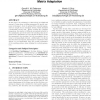Free Online Productivity Tools
i2Speak
i2Symbol
i2OCR
iTex2Img
iWeb2Print
iWeb2Shot
i2Type
iPdf2Split
iPdf2Merge
i2Bopomofo
i2Arabic
i2Style
i2Image
i2PDF
iLatex2Rtf
Sci2ools
GECCO
2010
Springer
2010
Springer
Evolving robust controller parameters using covariance matrix adaptation
In this paper, the advantages of introducing an additional amount of tests when evolving parameters for specific purposes is discussed. A set of optimal PID-controller parameters are sought for an exemplary system, which simulates a human-like robotic arm. When evolving the controller parameters, the number of different movements included in the optimization process is varied. By including extra movements to the optimization process, the time it takes to evolve the parameters does increase, but the uncertainty due to noise is correspondingly lowered. Additionally, it is shown that the added movements, which improve robustness of the system, do not significantly lower the overall performance of the resulting system, when utilizing the evolved parameters. Categories and Subject Descriptors I.2.8 [Artificial Intelligence]: Problem Solving, Control Methods, and Search—Control theory; I.2.9 [Artificial Intelligence]: Robotics—Manipulators; J.2 [Computer Applications]: Physical Sci...
| Added | 12 Oct 2010 |
| Updated | 12 Oct 2010 |
| Type | Conference |
| Year | 2010 |
| Where | GECCO |
| Authors | Gerulf K. M. Pedersen, Martin V. Butz |
Comments (0)

